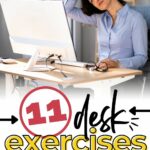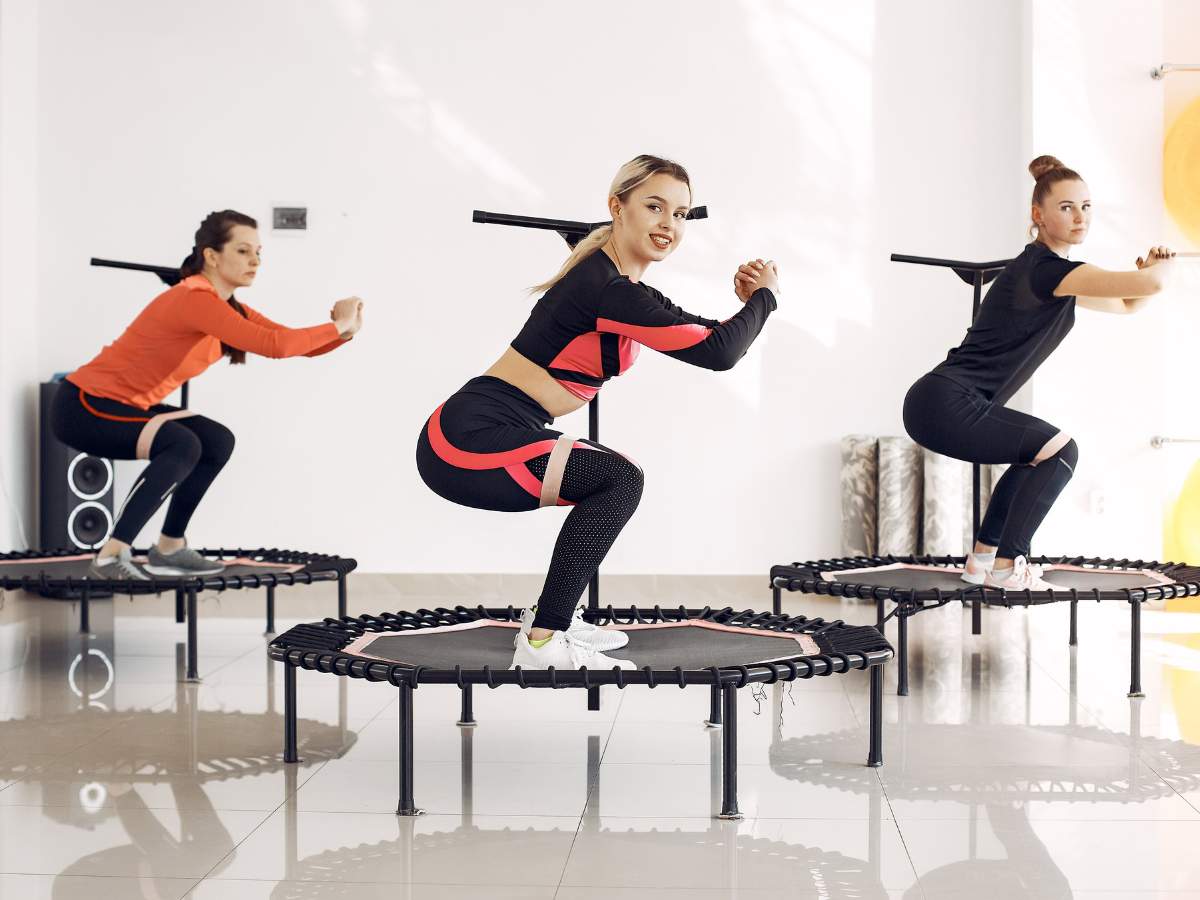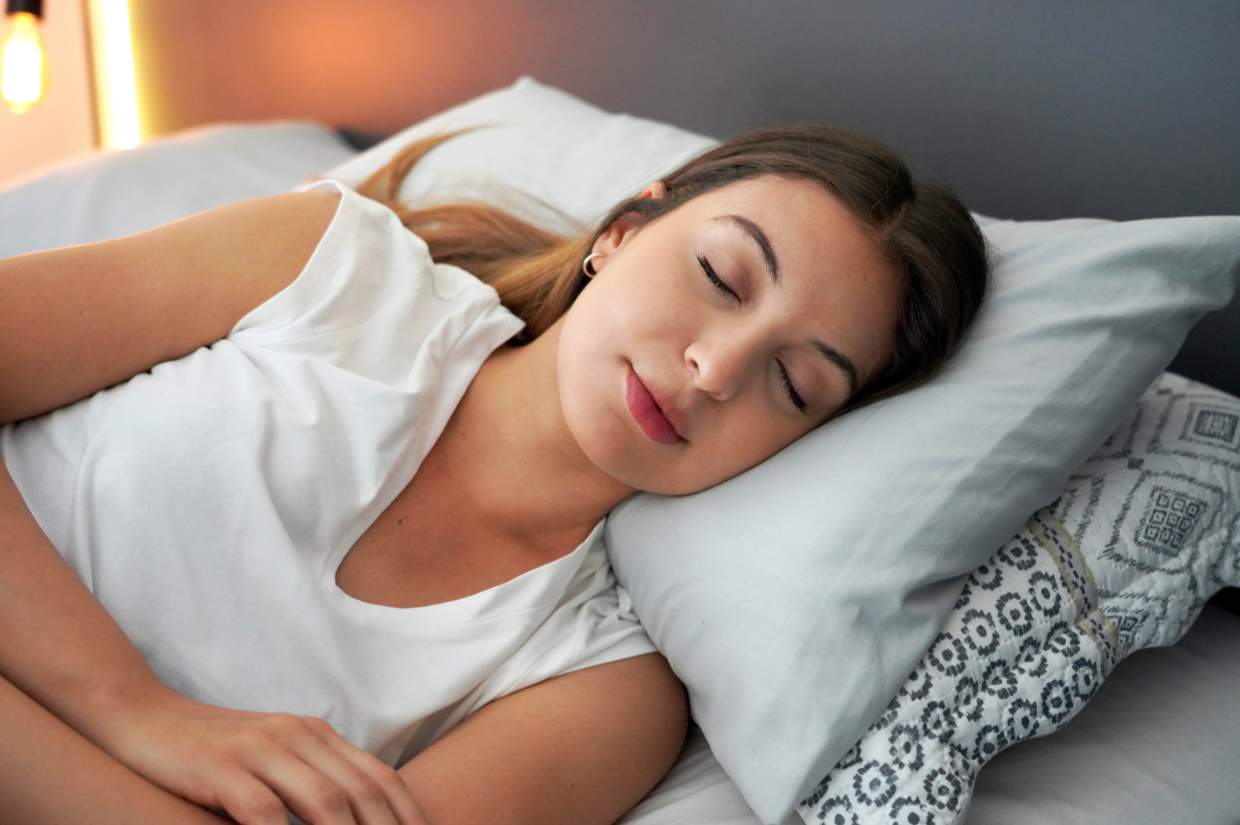11 Desk Exercises That Are Better Than A Cup of Coffee
Primal Edge Health participates in the Amazon Services LLC Associates Program and other affiliate programs and therefore, may collect a share of sales or other compensation from the links on this page. This comes at no additional cost to you, and all the prices and availability are accurate at the time of publishing.
If you haven’t started doing desk exercises at work yet, you’ll probably regret not starting sooner. While exercising at your desk won’t beat a full-blown workout, it can help you stay energized, limber and focused throughout the day.
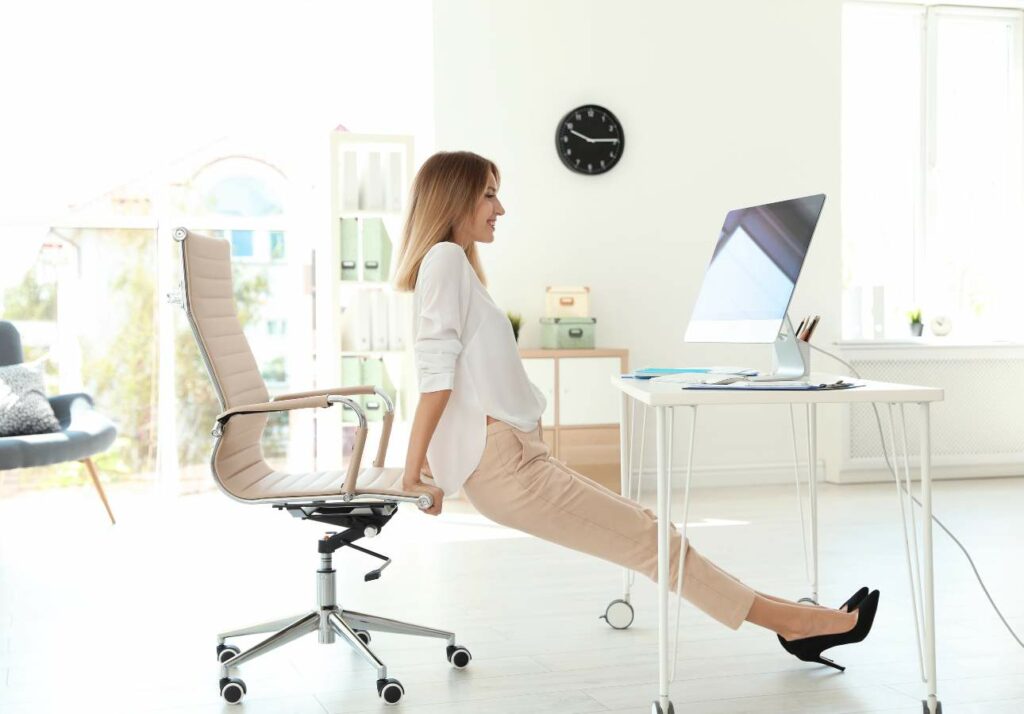
Does your job keep you at your desk for most of the day? Do you feel tired, sore and sleepy from all that sitting? Well, it might be time to add desk exercises to your daily routine for a healthier lifestyle.
Table of Contents (click to view)
Why Exercise at Your Desk?
Exercise is essential for optimal health. People with active jobs can get most of their exercise simply by just doing their duties. However, it’s a different story for people with desk jobs.
Sure, you can just exercise after you clock out, but why wait? I do simple desk exercises while I’m at work, then follow them up quick trampoline exercises at home. Feels so good!
Here are several reasons why you should start exercising at your desk today:
- Exercising is relaxing: Physical activity is one of the best methods of natural stress relief. Even if it’s just stretching, moving your body around can release those happy hormones that keep you calm and in a good mood.
- You can relieve pain: UCLA Health says that sitting for prolonged periods can lead to pain in your back, neck, bottom and limbs. Getting up to do a desk exercise can help prevent that by keeping your muscles and joints loose.
- You’ll be more productive: According to Robert Pozen from Brookings, exercising increases oxygen in your blood, which will make you feel more alert, awake and focused on your work.
- You may be able to sleep better: If you expend more energy during your workday, you may be able to fall asleep faster at night, which can keep your circadian rhythm on the right track.
- You can prevent long-term health issues: Prolonged sitting is linked to various health problems, including cardiovascular diseases, obesity, and diabetes, says Yale Medicine. Incorporating desk exercises can mitigate these risks by promoting better circulation and maintaining a healthy metabolism.
- You may feel less crabby: Feeling irritable in the office? Regular movement can improve your mood and overall well-being, which can help you feel happier and more content during your workday.
The best part is that desk exercises can take as little as five minutes and they will still provide some benefit. Even if it’s just two or three mini-workouts, it can make a difference.
“I’m a fan of 5-Minute Fitness, which means I take a five-minute break every so often and find a way to move. When in the office, I favor chair squats, obliques, stretches and neck rolls. I find that prioritizing just 5 minutes is practical and effective because it adds up throughout the day!”
— Shelby, Fit As A Mama Bear
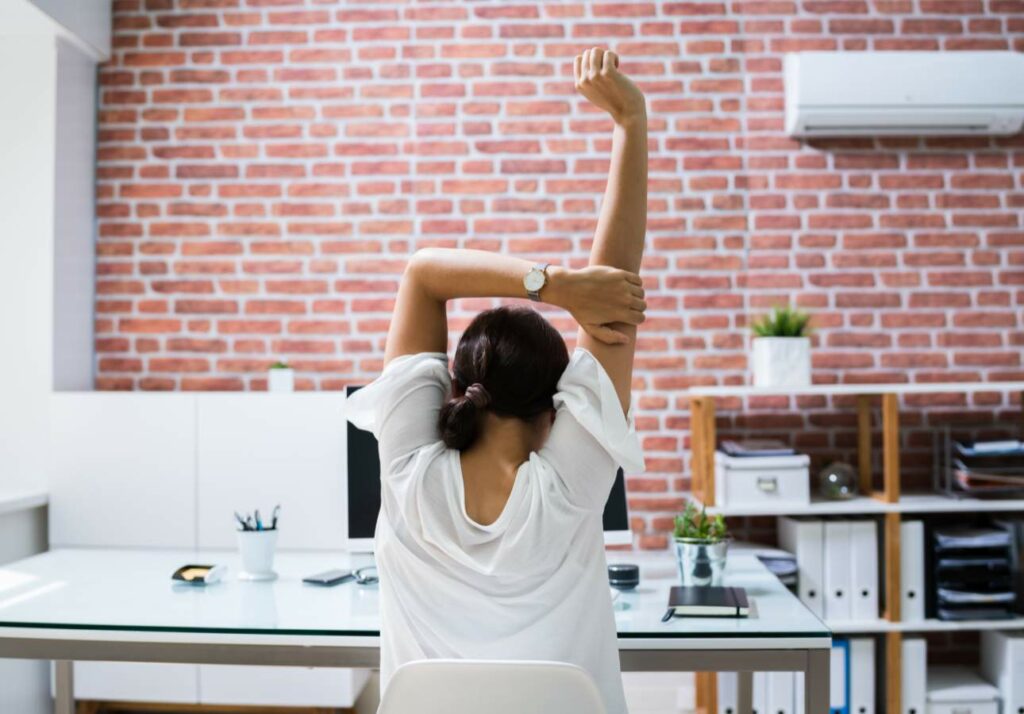
Simple Exercises You Can Do at Your Desk
The beauty of desk exercises is you won’t have to leave your seat to do it. Here are some simple mini-workouts you can try:
1. The Seated Twist
While seated with a straight spine, place your right hand on the outer side of your left knee. Use this hand for support as you gently twist to the left, reaching your left hand as far right as possible for stability. Sync this movement with your breath.
Exhale as you deepen the twist, and inhale as you release. Repeat on both sides two to three times.
2. Triceps Dips
You need a stable, non-wheeled chair for this. Start by sitting towards the edge of the chair, with your hands facing forward. Place your palms flat on the chair, and gently bend your elbows straight back as you lower yourself a few inches. Keep your back close to the chair.
Then, straighten your arms to return to the starting position. Repeat this move 15 to 20 times.
3. The Chest Opener
Perched at the edge of your chair, interlace your hands behind your back, gently expanding your chest and shoulders. Inhale deeply, feeling your chest rise and your shoulders pull back, opening up your chest.
As you exhale slowly, maintain the stretch, noticing how it intensifies with each breath. Repeat this sequence two to three times, allowing each breath to deepen the stretch and promote relaxation.
4. Chair Squats
This one is pretty self-explanatory. Simply get up from your chair, stand to full height, then do a standard squat without letting your butt hit the chair.
Make sure your feet are shoulder-width apart, and your toes are pointed slightly outward. Engage your core and keep your chest lifted as you lower yourself back down towards the chair, stopping just before your butt touches the seat.
Push through your heels to return to the standing position. Repeat this movement 10 times to strengthen your thighs, glutes, and core.
5. Chair Bicycle
While sitting in your chair with your feet firmly planted on the floor, place your hands behind your head. Lift one knee towards the opposite elbow, twisting your body down towards it, then return to the upright, seated position with a straight back. Alternate sides and repeat as many times as you want.
6. The Hip Flexor Stretch
Sit at the edge of your chair, but shift your position to face left. Extend your right leg straight behind you, focusing on keeping the knee as straight as possible. Sit up tall, lifting your sternum and gently tucking your tailbone under. Repeat as many times as you want.
7. Chair Obliques
Take advantage of your swivel chair to target your oblique muscles. Start by sitting upright in your chair, with your feet slightly lifted off the floor. Grip the edge of your desk for stability. Engage your core muscles as you use them to swivel the chair from side to side. Repeat 20 times.
8. The Shoulder Stretch
Here’s something that we all do from time to time. To do this move, clasp your hands together and stretch your arms upward. Hold the pose for two to three deep breaths or until you feel some relief in your back muscles.
9. Neck Rolls
Lower your chin towards your chest and gently rotate your neck in a circular motion. Then, lift your chin upward and tilt your head to each side, holding the stretch for about 10 seconds on each side. Repeat these movements as necessary throughout the day to release tension in your neck and shoulders.
10. Seated Leg Extensions
Extend one leg until it’s level with your hips. Hold this position for as long as it is comfortable, feeling the engagement in your thigh muscles. Keep your back straight and your core engaged to maintain stability.
After holding the position, slowly relax and return the leg to its original position. Repeat this movement, aiming for 10 repetitions on each leg.
11. Seated Band Abduction
If you have a resistance band at home, take it with you to the office to try this desk workout. Sit comfortably on a sturdy chair with your torso upright and feet firmly planted on the ground. Secure a mini-band below your knees to establish the starting position.
Push your knees outward against the resistance of the band while focusing on engaging the small muscles on the sides of your buttocks. Then, slowly bring your knees back together to complete one rep.
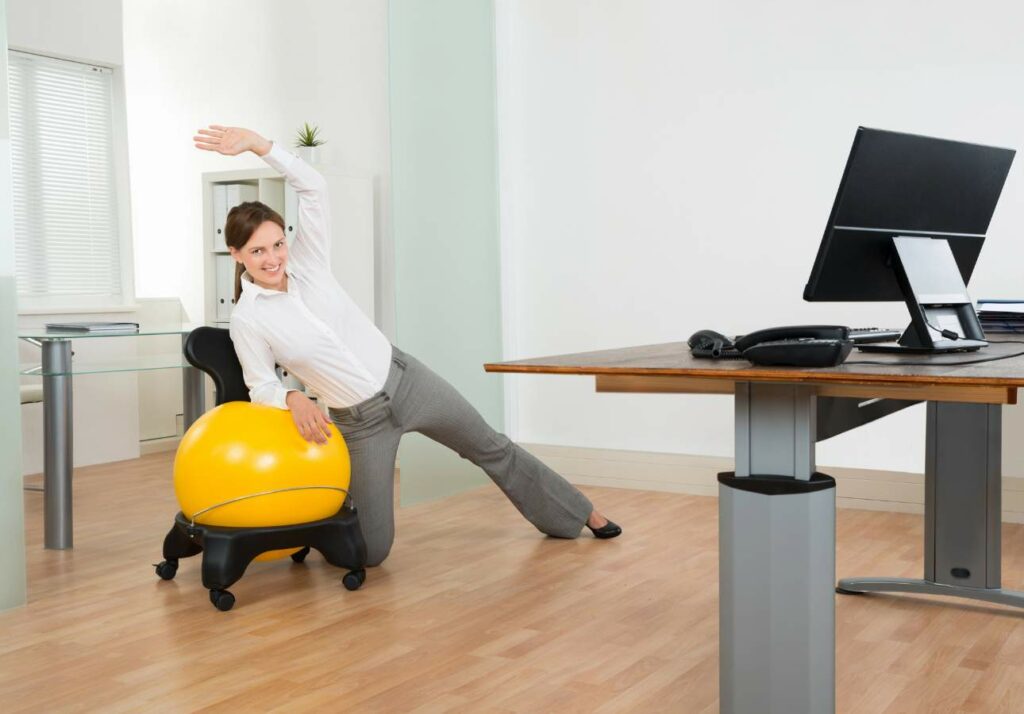
Upgrade Your Workspace with Exercise Equipment
Want to take your desk exercises more seriously? Consider these upgrades that can help you stay active, relieve stress and improve your overall well-being even further.
- Exercise ball: Ditch your standard chair for an exercise ball! Not only will it improve your posture, but it will also strengthen your core and enhance your balance. Sitting on an exercise ball engages your abs, promoting better spinal alignment and reducing back pain.
- Resistance bands: Use them for seated leg lifts, arm stretches, and seated rows. These bands provide a quick, low-impact way to tone your muscles while sitting.
- Hand weights: Keep a set of light hand weights at your desk for quick strength-training sessions. Perform bicep curls, shoulder presses and tricep extensions during short breaks to build muscle and boost your metabolism.
- Standing desk: Upgrade to a standing desk to switch between sitting and standing throughout the day. Standing more often can reduce back pain, improve posture and increase your overall energy levels.
- Walking pad: Take your standing desk to the next level with a walking pad. This compact treadmill fits under your desk, allowing you to walk while you work. It’s a fantastic way to stay active, burn calories and improve your cardiovascular health.
Other Great Ways to Energize Your Day
Still feeling drowsy after a round of desk workouts? Here are other ways to give yourself a much-needed energy boost:
- Try coffee alternatives if you want to reduce your caffeine intake.
- Switch to a bone broth latte for long-lasting energy without the coffee jitters.
- Take a lap around the office or maybe even take a short walk outside.
- Try small, frequent feeding instead of a heavy meal during your break.
- Put peppermint, spearmint, lemon and other energizing essential oils in a diffuser.
- Make sure you drink plenty of water throughout the day; dehydration can lead to fatigue
- Listen to upbeat music to combat drowsiness
- Take a quick 10-20 minute power nap, if possible
- Expose yourself to natural light, especially if your desk is under mostly artificial light
Make Your Workday More Fun with Desk Exercises
One of the best ways to start your day is with a cup of coffee, but that initial energy boost won’t last all day. Instead of reaching for another cup, try desk exercises instead.
Portions of this article originally appeared on Food Drink Life.

